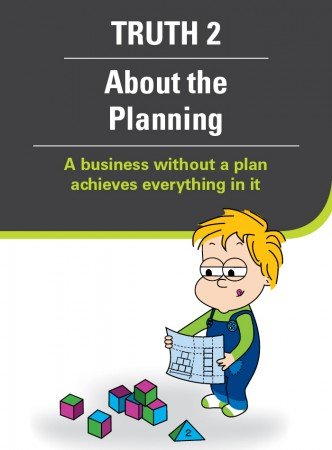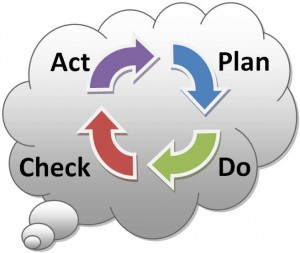Business plans that work.
A business without a plan achieves everything in it.
What does it take to make a success of your small business… how can you avoid adding to those frightening statistics about failure rates of small business?
In this series of articles and associated webinars and workshops, you will learn the basic concepts and get the knowledge you need to become a successful ‘Business-Owner’, as opposed to a struggling ‘Business-Doer’, and build a business that sustains you for years to come.
The First Steps Format
The format of each episode in the “First Steps” series is to explain the basics of the topic and then to suggest some “First Steps” you can take straight away to put the knowledge into action. The previous articles On Purpose, Financial Management, Marketing and Sales can be found in the archive on the blog.
In the fifth of these articles we’ll look at Planning and ask:
Why do so few business owners have a business plan, or if they do have one, why don’t they look at it more often, and how can we create a plan that does make a difference?

I bet you actually have a business plan. You probably created it with the help of your accountant or by following a template you downloaded from a government website somewhere. You filled in the blanks and fiddled with it a bit. It made the bank happy. It looks great and when you finished it, you felt proud to hold it in your hand. But when was the last time you even looked at the thing?
We all know the mantra: If you want to build a successful business, you must have a Business Plan.
I completely agree with that mantra, but does that mean that a business with a “Plan” will by default be successful?
No, obviously not. Most business plans don’t actually have much of an impact on the success of a business, because their format and content is irrelevant for business owners and their staff.
So how do you write a business plan that is relevant for you and your business? A business plan that is your most powerful tool to guide the direction and development of your business?
Business Bedtime Story, Laura
Here is one of my Business Bedtime Stories that illustrates how to think about planning. The Story is about one of my clients, Laura.

Once upon a time… a long long time ago in a country not unlike Australia… Laura had a fashion label…
Laura had a little shop in Sydney and a fashion label and a small dedicated band of followers for her unique brand of office fashion for successful corporate women.
Laura’s business was 4 years old and although it was gratifying to see the same customers come back season after season for her latest lines and to know how happy her customers usually were when they left her shop, Laura felt strongly that there was a great opportunity for her to grow the business and bring her unique designs to a larger audience, but she just didn’t know where to start.
“Should I get involved in social media, or maybe I need to take the plunge and open a shop in the CBD or should I look for a partner in Melbourne or knock on the door of Myer, and how will I finance an expansion, and can I continue to manufacture in Australia, and what if I am not good enough to manage more staff and various localities, and is the market in Perth the same as the market in Sydney, and what if Cue designs simply decides to knock off my designs, and if I grow will I lose the loyalty of my customers” ? etc etc
Paralysis

Laura was stuck in a classic decision paralysis loop.
Working with me, Laura came to realise that the only way to cut through her dilemma’s was to face her lack of confidence in business planning head on write a thorough Business Plan, but in a form that worked for her.
So she did. Laura started by creating a big mind-map in which she wrote down all the dilemmas and questions and then she systematically ordered them, prioritised them and answered them.
The mind-map evolved to a series of small one page documents for different aspects of the business and a time line with projections for different stages of the business development.
A place for all the questions
From there Laura simply started to work progressively through the plan, and every time another question or dilemma came up she went to the plan, and found a place to house the question. This simple process of planning allowed her to be able to focus on the immediate step ahead without being afraid that she would forget something crucial.

Making this step to getting involved in an appropriate level of consistent planning is the one thing that started to shift Laura’s business into a new realm.
1.5 Years later, Laura had opened a second shop in Sydney. The planning process helped her understand that her opportunities in the short to medium term were not in the CBD, nor in large scale production off-shore, but in a series of small unique shops in specific inner city suburbs like Balmain and Mosman, followed by similar expansion in Melbourne and other major cities in Australia.
Laura was looking forward to the next 5 years of consistent controlled growth and building a loyal national following of her label.
And Laura lived happily ever after… The End
The lessons
Let’s examine Laura’s lessons.
We’ll start at the beginning. Why do we need a “Business Plan”?
The purpose of creating and having a business plan is threefold:
1) To spell out exactly where the business is headed and how it will get there.
2) To have a fixed set of criteria to “test” every decision in the business against.
3) To know your options and to be able to make swift and accurate decisions when your business circumstances change from the ones you planned for.
If your Business Plan is designed with those three principles in mind, you can be sure it won’t be kept in the bottom of a drawer. It will sit on top of your desk; it will be dog-eared, and smudged; it will have coffee stains, scribbles and doodles all over it. You will look at it every day and so will everyone else who has anything to do with it.
Business Plans that live
There are 6 key criteria that a Business Plan must meet for it to truly add to the success of the business:
1) It must be a “live” document and be kept “live” by the people directly affected by it, monthly, quarterly, annually.
2) It must be designed with the people who are directly affected by it in mind.
3) It must be easy to use and easily accessible for the people directly affected by it.
4) It must be designed to address the short, medium and long-term goals of the business.
5) It must reflect the Purpose and Mission of the Business (see last month’s topic article on my blog)
6) It must be short… on page… ideally.
On the special resources page for this topic (follow this link) are a couple of simple templates that you can download and work your way through to create a business plan that meets these 6 criteria. All of the templates are designed to fit on one page.
None of the templates on the resources page are for business plans designed to go to the bank with. Those plans are external plans. The plans I talk about in this article and the plan that Laura created are internal plans, their function is to help you and your people drive the business to where you want it to go.
Your First Steps:
As usual in this series of articles I want to encourage you to take action. To get started with creating a business plan that is going to help you build a business that sustains you for years to come, the first step is to follow the link to the special resources for this article and download the two templates. There are also a couple of articles about planning from two internationally renowned business gurus you may want to read.
Step 2 is to get started. Put aside an hour to get familiar with either of the templates. Alternatively you might prefer Laura’s approach or you may decide on a different format altogether. It doesn’t matter, as long as you get started.
I’d love to hear how you go, email me your first draft or feel free to contact me with any questions.
Planning and the 7 Big Questions of Small Business
Business owners frequently ask 7 Big Questions about how to Build a Beautiful Business and Life.
The first of these Big Questions is: How do I grow my business?
To answer that question I have identified the 11 most important strategies to create Business Growth.
The sixth of those strategies is Grow your business with Planning. This is one article of several on this site, that explains how Planning and Growth hang together, in some depth.

The Masterminds sessions.
Every month I run a business development workshop as well as a webinar called “The Small Business Masterminds”. In December our topic for the Masterminds sessions is business planning and how to write a plan that works. For more information and to register for the next webinar or workshop, follow this link. First time free, normally $99
(By the way. Feel free to email me if you do want a good external business plan template to apply for an overdraft with.)
I agree with the authors comments about a business plan that lives. I use a platform called Podio to bring it to life. I can share my plan within seconds to people – be it internal or external. Cheers..Paul